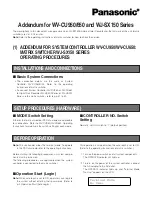
Area Types
The backbone of the network is Area 0. It is also called Area 0.0.0.0 and is the core of any AS. All other areas
must connect to Area 0.
An OSPF backbone is responsible for distributing routing information between areas. It consists of all area
border routers, networks not wholly contained in any area, and their attached routers.
NOTE:
If you configure two non-backbone areas, then you must enable the B bit in OSPF.
The backbone is the only area with a default area number. All other areas can have their Area ID assigned in
the configuration.
In the previous example, Routers A, B, C, G, H, and I are the Backbone.
• A stub area (SA) does not receive external route information, except for the default route. These areas do
receive information from inter-area (IA) routes.
NOTE:
Configure all routers within an assigned stub area as stubby, and not generate LSAs that do
not apply. For example, a Type 5 LSA is intended for external areas and the Stubby area routers may
not generate external LSAs.
• A not-so-stubby area (NSSA) can import AS external route information and send it to the backbone. It
cannot receive external AS information from the backbone or other areas.
• Totally stubby areas are referred to as no summary areas in the Dell Networking OS.
Networks and Neighbors
As a link-state protocol, OSPF sends routing information to other OSPF routers concerning the state of the
links between them. The state (up or down) of those links is important.
Routers that share a link become neighbors on that segment. OSPF uses the Hello protocol as a neighbor
discovery and keep alive mechanism. After two routers are neighbors, they may proceed to exchange and
synchronize their databases, which creates an adjacency.
Router Types
Router types are attributes of the OSPF process.
A given physical router may be a part of one or more OSPF processes. For example, a router connected to
more than one area, receiving routing from a border gateway protocol (BGP) process connected to another
AS acts as both an area border router and an autonomous system router.
Each router has a unique ID, written in decimal format (A.B.C.D). You do not have to associate the router ID
with a valid IP address. However, to make troubleshooting easier, Dell Networking recommends that the
router ID and the router’s IP address reflect each other.
Open Shortest Path First (OSPFv2 and OSPFv3)
710
Summary of Contents for S4048T
Page 1: ...Dell Configuration Guide for the S4048T ON System 9 10 0 1 ...
Page 98: ... saveenv 7 Reload the system uBoot mode reset Management 98 ...
Page 113: ...Total CFM Pkts 10303 CCM Pkts 0 LBM Pkts 0 LTM Pkts 3 LBR Pkts 0 LTR Pkts 0 802 1ag 113 ...
Page 411: ...mode transit no disable Force10 Resilient Ring Protocol FRRP 411 ...
Page 590: ...Figure 67 Inspecting the LAG Configuration Link Aggregation Control Protocol LACP 590 ...
Page 646: ...Figure 87 Configuring Interfaces for MSDP Multicast Source Discovery Protocol MSDP 646 ...
Page 647: ...Figure 88 Configuring OSPF and BGP for MSDP Multicast Source Discovery Protocol MSDP 647 ...
Page 653: ...Figure 91 MSDP Default Peer Scenario 2 Multicast Source Discovery Protocol MSDP 653 ...
Page 654: ...Figure 92 MSDP Default Peer Scenario 3 Multicast Source Discovery Protocol MSDP 654 ...
Page 955: ...Figure 119 Single and Double Tag First byte TPID Match Service Provider Bridging 955 ...
















































